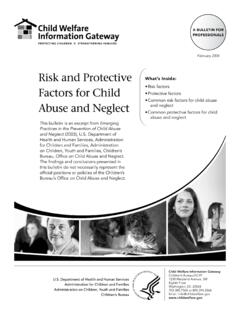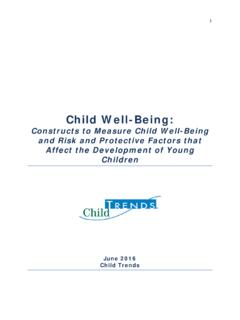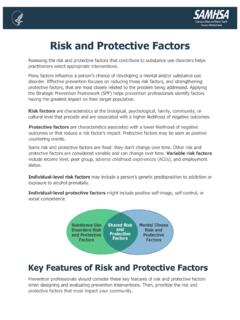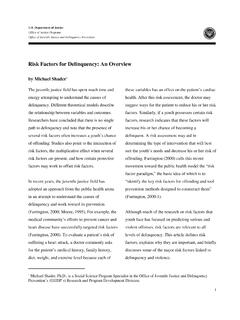Transcription of What Factors Contribute to Child Abuse and Neglect?
1 A Coordinated Response to Child Abuse and Neglect: The Foundation for Practice 27 CHAPTER 5 What FactorsContribute to Child Abuse and Neglect? There is no single known cause of Child maltreatment. Nor is there any single description that captures all families in which children are victims of Abuse and neglect. Child maltreatment occurs across socio-economic, religious, cultural, racial, and ethnic groups. While no specific causes definitively have been identified that lead a parent or other caregiver to Abuse or neglect a Child , research has recognized a number of risk Factors or attributes commonly associated with maltreatment.
2 Children within families and environments in which these Factors exist have a higher probability of experiencing maltreatment. It must be emphasized, however, that while certain Factors often are present among families where maltreatment occurs, this does not mean that the presence of these Factors will always result in Child Abuse and neglect. The Factors always result in Child Abuse and neglect. The Factors alwaysthat may Contribute to maltreatment in one family may not result in Child Abuse and neglect in another family. For example, several researchers note the relation between poverty and maltreatment, yet it must be noted that most people living in poverty do not harm their children.
3 Professionals who intervene in cases of Child maltreatment must recognize the multiple, complex causes of the problem and must tailor their assessment and treatment of children and families to meet the specific needs and circumstances of the family. Risk Factors associated with Child maltreatment can be grouped in four domains: Parent or caregiver Factors Family Factors Child Factors Environmental factorsIt is increasingly recognized that Child maltreatment arises from the interaction of multiple Factors across these four The sections that follow examine risk Factors in each category.
4 Available research suggests that different Factors may play varying roles in accounting for different forms of Child maltreatment (physical Abuse , sexual Abuse , neglect, and psychological or emotional Abuse ). Some of these differences are highlighted throughout the chapter. A greater understanding of risk Factors can help professionals working with children and families both to identify maltreatment and high-risk situations and to intervene appropriately. Assessment of the specific risk Factors that affect a family may influence the prioritization of intervention services for that family ( , substance Abuse treatment).
5 Moreover, addressing risk and protective Factors can help to prevent Child Abuse and neglect. For example, prevention programs may focus on increasing social supports for families (thereby reducing the risk of social isolation) or 28 What Factors Contribute to Child Abuse and Neglect? 29providing parent education to improve parent s age-appropriate expectations for their children. Prevention activities and their link to risk Factors are discussed further in Chapter 7, What Can Be Done to Prevent Child Abuse and Neglect? PARENT OR CAREGIVER Factors Parent or caregiver Factors potentially contributing to maltreatment relate to: Personality characteristics and psychological well-being History of maltreatment Substance Abuse Attitudes and knowledge AgePersonality Characteristics andPsychological Well-beingNo consistent set of characteristics or personality traits has been associated with maltreating parents or caregivers.
6 Some characteristics frequently identified in those who are physically abusive or neglectful include low self-esteem, an external locus of control ( , belief that events are determined by chance or outside forces beyond one s personal control), poor impulse control, depression, anxiety, and antisocial While some maltreating parents or caregivers experience behavioral and emotional difficulties, severe mental disorders are not Histories and the Cycle of Abuse A parent s childhood history plays a large part in how he or she may behave as a parent. Individuals with poor parental role models or those who did not have their own needs met may find it very difficult to meet the needs of their the estimated number varies.
7 Child maltreatment literature commonly supports the finding that some maltreating parents or caregivers were victims of Abuse and neglect themselves as One review of the relevant research suggested that about one-third of all individuals who were maltreated will subject their children to Children who either experienced maltreatment or witnessed violence between their parents or caregivers may learn violent behavior and may also learn to justify violent behavior as An incorrect conclusion from this finding, however, is that a maltreated Child will always grow up to become a maltreating parent.
8 There are individuals who have not been abused as children who become abusive, as well as individuals who have been abused as children and do not subsequently Abuse their own children. In the research review noted above, approximately two-thirds of all individuals who were maltreated did not subject their children to Abuse or It is not known why some parents or caregivers who were maltreated as children Abuse or neglect their own children and others with a similar history do While every individual is responsible for his or her actions, research suggests the presence of emotionally supportive relationships may help lessen the risk of the intergenerational cycle of Substance Abuse Parental substance Abuse is reported to be a contributing factor for between one- and two-thirds of maltreated children in the Child welfare supports the association between substance Abuse and Child For example.
9 A retrospective study of maltreatment experience in Chicago found children whose parents abused alcohol and other drugs were almost three times likelier to be abused and more than four times likelier to be neglected than children of parents who were not substance 28A Coordinated Response to Child Abuse and Neglect: The Foundation for Practice29 A Department of Health and Human Services study found all types of maltreatment, and particularly neglect, to be more likely in alcohol-abusing families than in nonalcohol-abusing Abuse can interfere with a parent s mental functioning, judgment, inhibitions, and protective capacity.
10 Parents significantly affected by the use of drugs and alcohol may neglect the needs of their children, spend money on drugs instead of household expenses, or get involved in criminal activities that jeopardize their children s health or Also, studies suggest that substance Abuse can influence parental discipline choices and Child -rearing the past decade, prenatal exposure of children to drugs and alcohol during their mother s pregnancy and its potentially negative, developmental consequences has been an issue of particular concern. The number of children born each year exposed to drugs or alcohol is estimated to be between 550,000 and 750, While this issue has received much attention, children who are exposed prenatally represent only a small proportion of children negatively affected by parental substance The number and complexity of co-occurring family problems often makes it difficult to understand the full impact of substance Abuse on Child Substance Abuse and Child maltreatment often co-occur with other problems, including mental illness.

















